2024届高三英语复习—— 政治、历史时间及文化渊源和文化遗产练习(含解析)
文档属性
| 名称 | 2024届高三英语复习—— 政治、历史时间及文化渊源和文化遗产练习(含解析) | 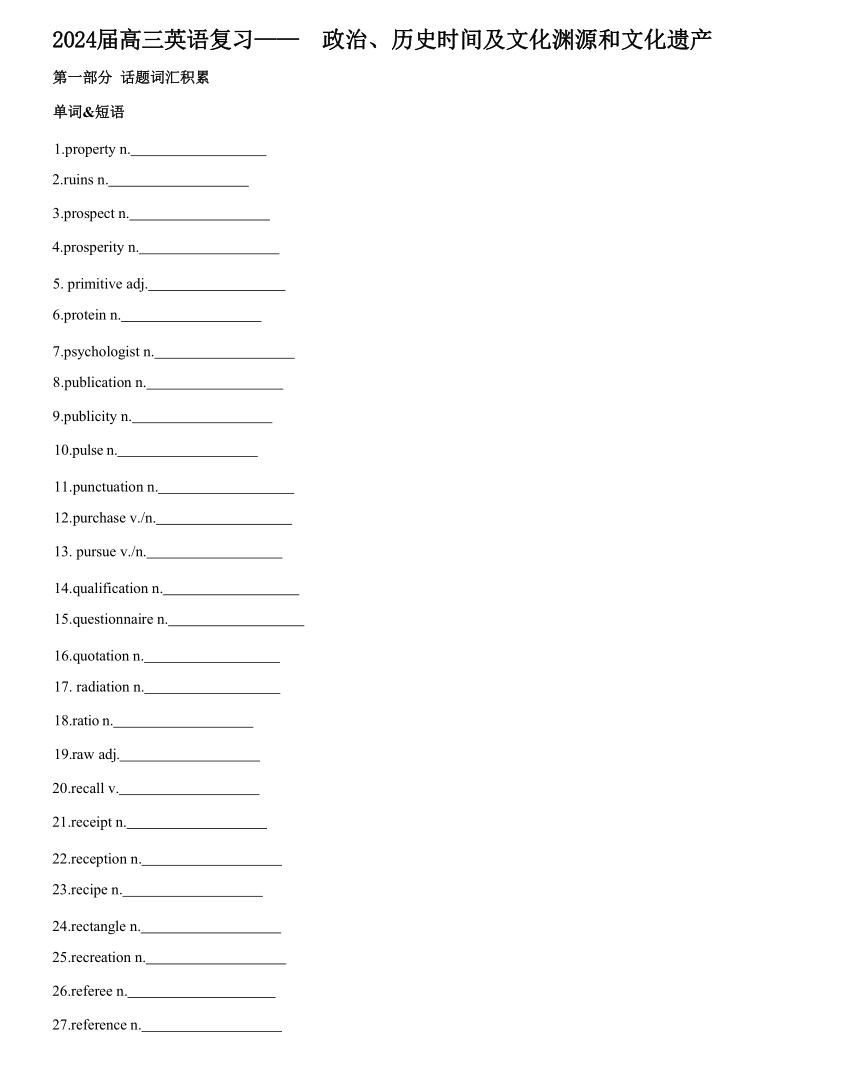 | |
| 格式 | docx | ||
| 文件大小 | 35.9KB | ||
| 资源类型 | 教案 | ||
| 版本资源 | 人教版(2019) | ||
| 科目 | 英语 | ||
| 更新时间 | 2024-02-12 21:44:44 | ||
图片预览

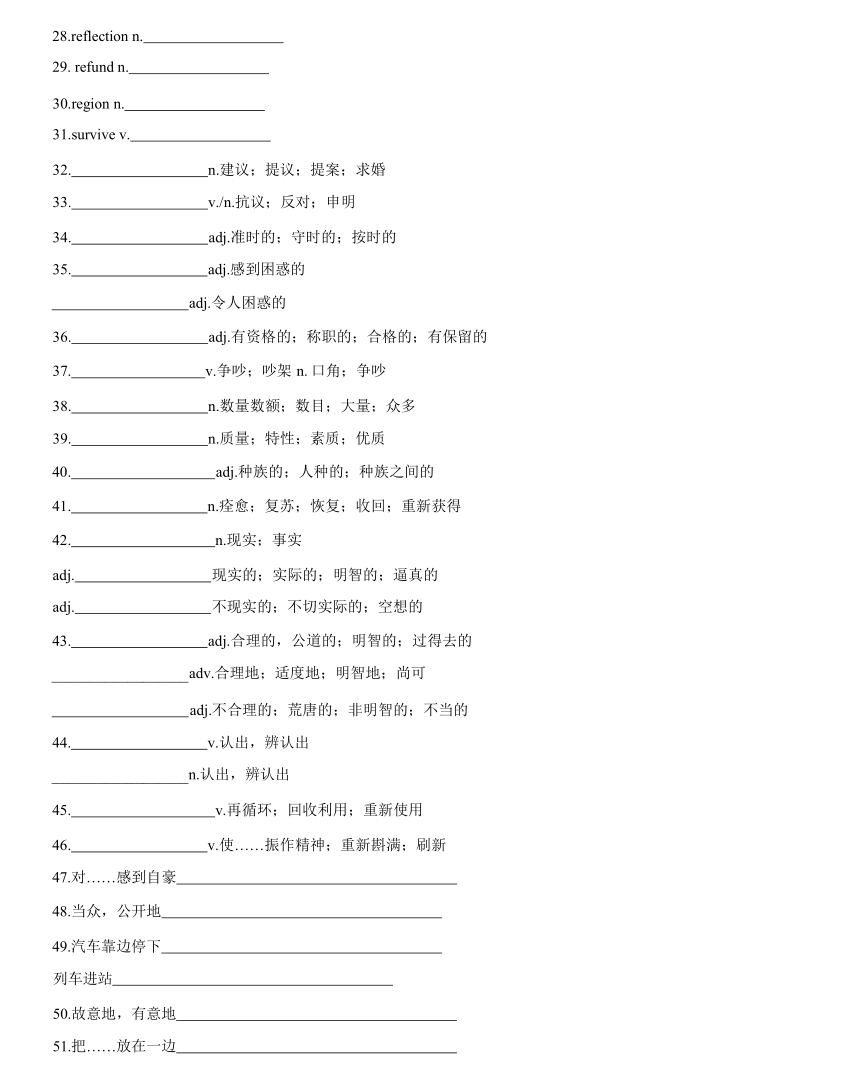
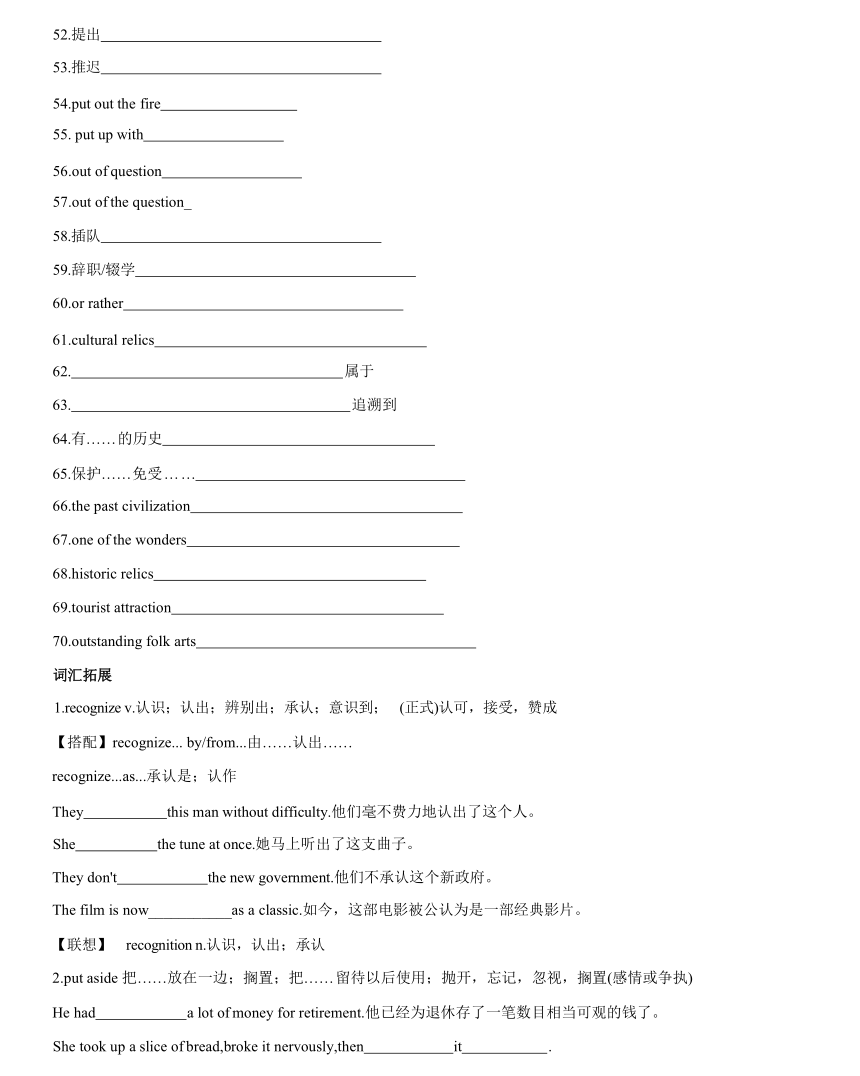
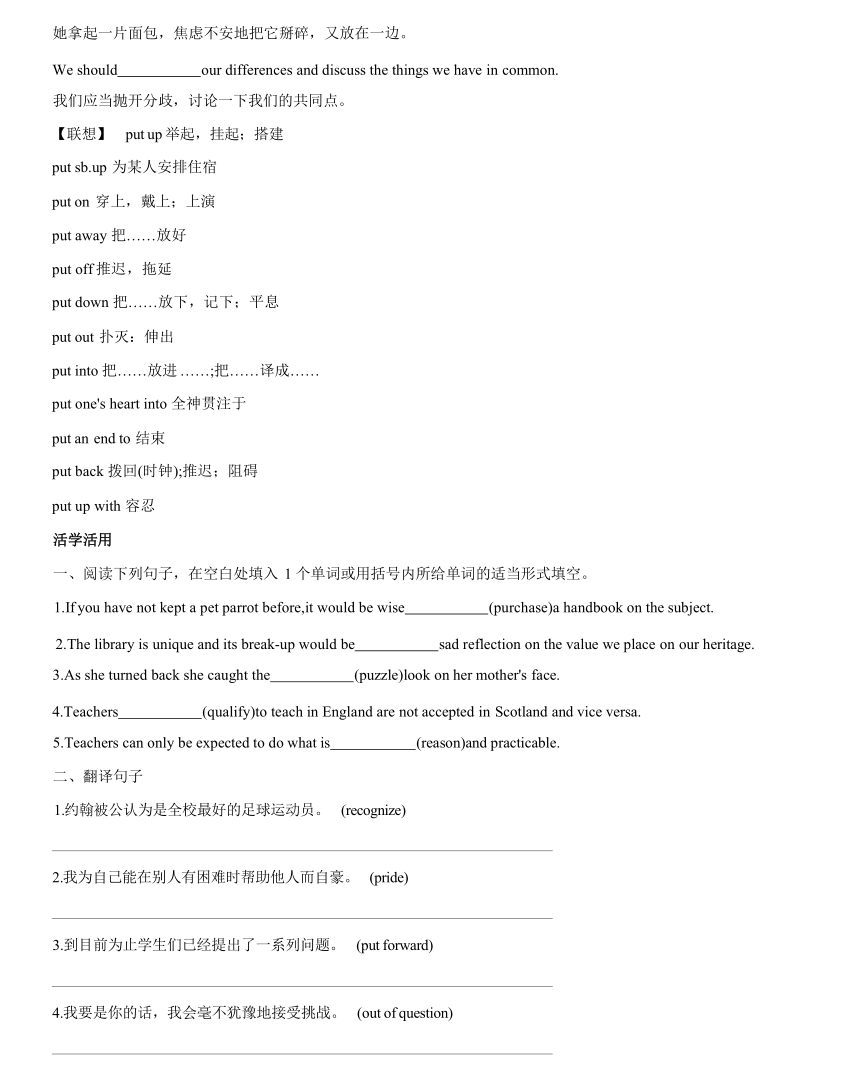
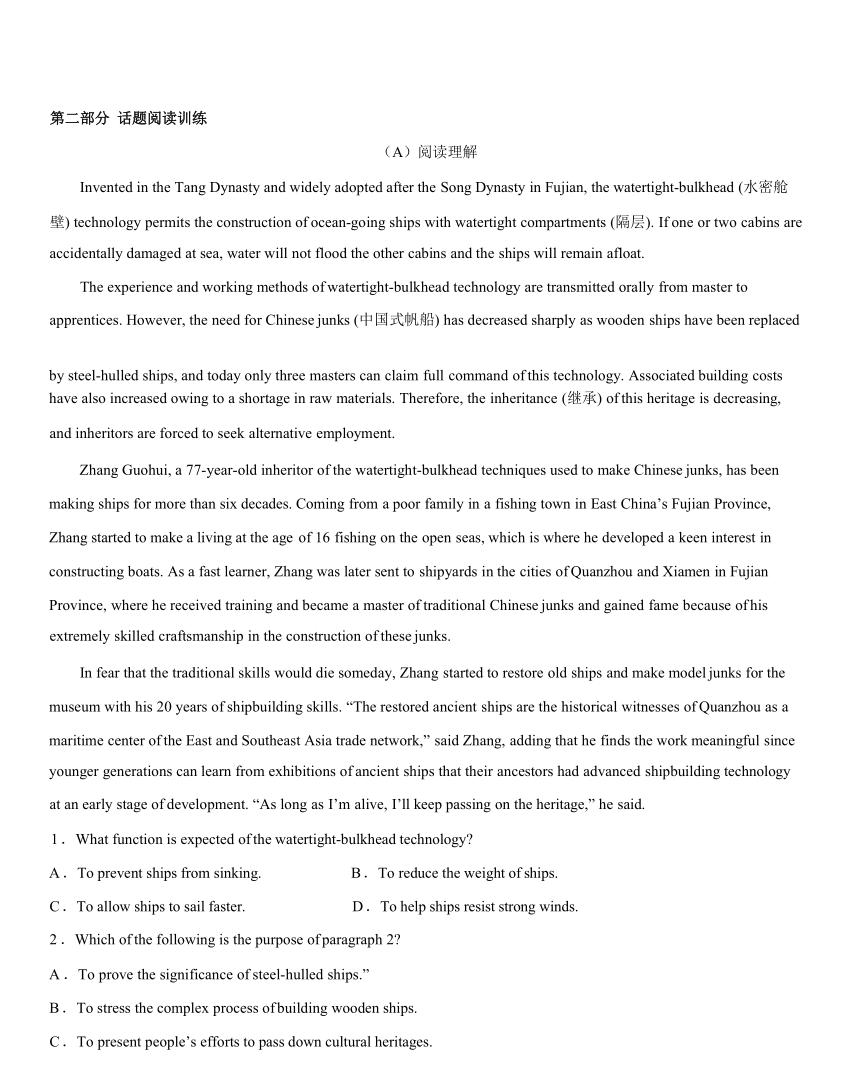
文档简介
2024届高三英语复习—— 政治、历史时间及文化渊源和文化遗产
第一部分 话题词汇积累
单词&短语
1.property n.
2.ruins n.
3.prospect n.
4.prosperity n.
5. primitive adj.
6.protein n.
7.psychologist n.
8.publication n.
9.publicity n.
10.pulse n.
11.punctuation n.
12.purchase v./n.
13. pursue v./n.
14.qualification n.
15.questionnaire n.
16.quotation n.
17. radiation n.
18.ratio n.
19.raw adj.
20.recall v.
21.receipt n.
22.reception n.
23.recipe n.
24.rectangle n.
25.recreation n.
26.referee n.
27.reference n.
28.reflection n.
29. refund n.
30.region n.
31.survive v.
32. n.建议;提议;提案;求婚
33. v./n.抗议;反对;申明
34. adj.准时的;守时的;按时的
35. adj.感到困惑的
adj.令人困惑的
36. adj.有资格的;称职的;合格的;有保留的
37. v.争吵;吵架 n. 口角;争吵
38. n.数量数额;数目;大量;众多
39. n.质量;特性;素质;优质
40. adj.种族的;人种的;种族之间的
41. n.痊愈;复苏;恢复;收回;重新获得
42. n.现实;事实
adj. 现实的;实际的;明智的;逼真的
adj. 不现实的;不切实际的;空想的
43. adj.合理的,公道的;明智的;过得去的
adv.合理地;适度地;明智地;尚可
__________________
adj.不合理的;荒唐的;非明智的;不当的
44. v.认出,辨认出
n.认出,辨认出
__________________
45. v.再循环;回收利用;重新使用
46. v.使……振作精神;重新斟满;刷新
47.对……感到自豪
48.当众,公开地
49.汽车靠边停下
列车进站
50.故意地,有意地
51.把……放在一边
52.提出
53.推迟
54.put out the fire
55. put up with
56.out of question
57.out of the question_
58.插队
59.辞职/辍学
60.or rather
61.cultural relics
62. 属于
63. 追溯到
64.有…… 的历史
65.保护…… 免受 … …
66.the past civilization
67.one of the wonders
68.historic relics
69.tourist attraction
70.outstanding folk arts
词汇拓展
1.recognize v.认识;认出;辨别出;承认;意识到; (正式)认可,接受,赞成
【搭配】recognize... by/from...由……认出……
recognize...as...承认是;认作
They this man without difficulty.他们毫不费力地认出了这个人。
She the tune at once.她马上听出了这支曲子。
They don't the new government.他们不承认这个新政府。
The film is now as a classic.如今,这部电影被公认为是一部经典影片。
___________
【联想】 recognition n.认识,认出;承认
2.put aside 把……放在一边;搁置;把…… 留待以后使用;抛开,忘记,忽视,搁置(感情或争执)
He had a lot of money for retirement.他已经为退休存了一笔数目相当可观的钱了。
She took up a slice of bread,broke it nervously,then it .
她拿起一片面包,焦虑不安地把它掰碎,又放在一边。
We should our differences and discuss the things we have in common.
我们应当抛开分歧,讨论一下我们的共同点。
【联想】 put up 举起,挂起;搭建
put sb.up 为某人安排住宿
put on 穿上,戴上;上演
put away 把……放好
put off 推迟,拖延
put down 把……放下,记下;平息
put out 扑灭:伸出
put into 把……放进 ……;把……译成……
put one's heart into 全神贯注于
put an end to 结束
put back 拨回(时钟);推迟;阻碍
put up with 容忍
活学活用
一、阅读下列句子,在空白处填入 1 个单词或用括号内所给单词的适当形式填空。
1.If you have not kept a pet parrot before,it would be wise (purchase)a handbook on the subject.
2.The library is unique and its break-up would be sad reflection on the value we place on our heritage.
3.As she turned back she caught the (puzzle)look on her mother's face.
4.Teachers (qualify)to teach in England are not accepted in Scotland and vice versa.
5.Teachers can only be expected to do what is (reason)and practicable.
二、翻译句子
1.约翰被公认为是全校最好的足球运动员。 (recognize)
2.我为自己能在别人有困难时帮助他人而自豪。 (pride)
3.到目前为止学生们已经提出了一系列问题。 (put forward)
4.我要是你的话,我会毫不犹豫地接受挑战。 (out of question)
第二部分 话题阅读训练
(A)阅读理解
Invented in the Tang Dynasty and widely adopted after the Song Dynasty in Fujian, the watertight-bulkhead (水密舱 壁) technology permits the construction of ocean-going ships with watertight compartments (隔层). If one or two cabins are
accidentally damaged at sea, water will not flood the other cabins and the ships will remain afloat.
The experience and working methods of watertight-bulkhead technology are transmitted orally from master to
apprentices. However, the need for Chinese junks (中国式帆船) has decreased sharply as wooden ships have been replaced
by steel-hulled ships, and today only three masters can claim full command of this technology. Associated building costs
have also increased owing to a shortage in raw materials. Therefore, the inheritance (继承) of this heritage is decreasing,
and inheritors are forced to seek alternative employment.
Zhang Guohui, a 77-year-old inheritor of the watertight-bulkhead techniques used to make Chinese junks, has been making ships for more than six ing from a poor family in a fishing town in East China’s Fujian Province, Zhang started to make a living at the age of 16 fishing on the open seas, which is where he developed a keen interest in constructing boats. As a fast learner, Zhang was later sent to shipyards in the cities of Quanzhou and Xiamen in Fujian Province, where he received training and became a master of traditional Chinese junks and gained fame because of his
extremely skilled craftsmanship in the construction of these junks.
In fear that the traditional skills would die someday, Zhang started to restore old ships and make model junks for the museum with his 20 years of shipbuilding skills. “The restored ancient ships are the historical witnesses of Quanzhou as a maritime center of the East and Southeast Asia trade network,” said Zhang, adding that he finds the work meaningful since
younger generations can learn from exhibitions of ancient ships that their ancestors had advanced shipbuilding technology
at an early stage of development. “As long as I’m alive, I’ll keep passing on the heritage,” he said.
1 .What function is expected of the watertight-bulkhead technology
A .To prevent ships from sinking. B .To reduce the weight of ships.
C .To allow ships to sail faster. D .To help ships resist strong winds.
2 .Which of the following is the purpose of paragraph 2
A .To prove the significance of steel-hulled ships.”
B .To stress the complex process of building wooden ships.
C .To present people’s efforts to pass down cultural heritages.
D .To show difficulties of inheriting watertight-bulkhead technology.
3 .What can we learn about Zhang Guohui from paragraph 3
A .He supports his family by fishing.
B .He was born with a talent for shipbuilding.
C .He has devoted himself to constructing boats.
D .He has won many awards for restoring ancient ships.
4 .What does Zhang Guohui convey in his words
A .Traditional culture should be innovated with the times.
B .The ancient ship trade originated from Quanzhou in China.
C .It is necessary for modern students to learn shipbuilding skills.
D .It is worth passing on traditional skills from generation to generation.
(B)语法填空
The 53-year-old craftswoman Ji Yulan, an inheritor of the intangible heritage of paper-cutting from the Xinjiang Uygur
autonomous region, 11 (engage) herself in the art for over 40 years.
She made paper-cuts of people from other 12 (walk) of life. “The paper-cutting art comes from the folk and it should return to the people,” Ji said. She created 13 paper-cutting work named The Angel in Harm’s Way to show the image of a nurse who has her long hair back after cutting it to better fit into the protective suit while fighting in the front
line against the epidemic. Ji was 14 (deep) impressed by the female medical workers 15 (wear) masks and
protective hats. “Women are 16 (charm) in long hair and it takes a lot of courage to cut it, ” she said.
Ji has 12 students, 17 (age) from 3 to 23. “They discovered their interest in paper-cutting and came to me 18 (learn) it,” she said, adding that she often encourages her students to create works based 19 reality. “Younger generations have a real sense of cultural heritage, and that’s 20 I am incredibly optimistic about the future
of the craft. ”
参考答案
单词&短语
1.财产;所有权 2.废墟 3.前途,前景 4.成功,繁荣 5.原始的 6.蛋白质 7.心理学家 8.出版物 9.关注,宣传 10.脉搏 11.标点符号 12.购买 13.追求 14.资格,资格证书 15.问卷调查 16.引语 17.放射,辐射 18.比例;比率 19.未加工的; 生的 20.回忆;召回 21.收据,收条 22.接待;招待会 23.处方;秘诀;食谱 24.长方形 25.消遣,娱乐 26.裁判员
27.提及;参考 28.映像;反射;思考 29.退款 30.地区;范围 31.幸存 32.proposal 33.protest 34.punctual
35.puzzled;puzzling 36.qualified 37.quarrel 38.quantity 39.quality 40. racial 41. recovery 42. reality;realistic;unrealistic 43.
reasonable;reasonably;unreasonable44.recognize(s)e;recognition 45.recycle 46.refresh47.be proud of/take pride in 48.in
public 49.pullover;pull in 50.on purpose 51.put aside 52.put forward53.put off 54.灭火 55.忍受 56.毫无疑问 57.不可能;
办不到;无法接受 58.jump a queue 59.quit a job/quit school 60.更确切地说 61.文化遗产 62.belong to
63.date back to/from64. have a history of 65. protect...from... 66.过去的文明 67.奇迹之一 68.历史遗产 69.旅游胜地
70.优秀民间艺术
词汇拓展
1.recognized; recognized;recognize;recognized
2.put aside;put,aside;put aside
活学活用
一、1.to purchase 2.a 3.puzzled 4.qualified 5.reasonable
二、 1.John is recognized as the best footballer in the school.
2.I take pride in helping others when they are in trouble.
3.The students have put forward a series of questions so far.
4.If I were you I would out of question accept the challenge without the least hesitation.
1 .A 2 .D 3 .C 4 .D
【导语】这是一篇说明文。文章介绍了发明于唐代, 宋代以后在福建被广泛采用的水密舱壁技术, 现在随着木船被 钢铁船所取代, 今天只有三位大师可以完全掌握这项技术, 几近失传, 这是宝贵的中国非物质文化遗产。并介绍了
一位致力于该项技术推广与宣传的传承人——张国辉老人。
1.细节理解题。根据第一段“If one or two cabins are accidentally damaged at sea, water will not flood the other cabins and the ships will remain a float. (如果一两个舱室在海上意外损坏,水不会淹没其他舱室,船只将保持漂浮)”可知,水密
舱壁技术可以在船只部分受损的情况下,仍可以继续保持漂浮不下沉。故选 A 项。
2.推理判断题。根据第二段内容“The experience and working methods of watertight-bulkhead technology are transmitted
orally from master to apprentices. However, the need for Chinese junks(中国式帆船) has decreased sharply as wooden
ships have been replaced by steel-hulled ships, and today only three masters can claim full command of this technology.
Associated building costs have also increased owing to a shortage in raw materials. Therefore, the inheritance(继承) of this heritage is decreasing, and inheritors are forced to seek alternative employment. (水密舱壁技术的经验和工作方法由师傅 口头传授给徒弟。然而, 随着木船被钢壳船所取代, 对中国舢板的需求急剧减少, 今天只有三位大师可以声称完全 掌握这项技术。由于原材料短缺, 相关的建筑费用也增加了。因此, 这一遗产的继承性正在减少, 继承者被迫寻找
替代工作)”可知,本段在讲述当今时代传承这项技术的种种困难。故选 D 项。
3.推理判断题。根据第三段首“Zhang Guohui, a 77-year-old inheritor of the watertight-bulkhead techniques used to make Chinese junks, has been making ships for more than six decades. (继承了制造中国帆船的防水舱壁技术的77 岁老人张国
辉,已经有 60 多年的造船经验)”可知,张国辉老人一生都致力于造船事业。故选 C 项。
4.推理判断题。根据最后一段中“‘The restored ancient ships are the historical witnesses of Quanzhou as a maritime center
of the East and Southeast Asia trade network,’ said Zhang, adding that he finds the work meaningful since younger
generations can learn from exhibitions of ancient ships that their ancestors had advanced shipbuilding technology at an early stage of development. (张国辉说:‘这些被修复的古船是泉州作为东亚和东南亚贸易网络海上中心的历史见证。 ’他又 补充说他认为这项工作很有意义, 因为年轻一代可以从古船展览中了解到他们的祖先在早期发展阶段拥有先进的造
船技术)”可知,老人说这些话表明他认为致力于代代传承这一传统技艺是有意义的,是值得的。故选 D 项。
11 .has engaged/has been engaging 12 .walks 13 .a 14 .deeply 15 .wearing 16 .charming
17 .aged 18 .to learn 19 .on 20 .why
【导语】这是一篇记叙文。文章主要讲述了现年五十三岁的姬玉兰继承了新疆维吾尔自治区的非物质文化遗产, 从
事剪纸艺术已逾四十年。
11 .考查时态。句意:现年五十三岁的姬玉兰继承了新疆维吾尔自治区的非物质文化遗产,从事剪纸艺术已逾四十 年。此处在句中作谓语, 由 for over 40 years 和句意可知, 句子既可以用现在完成时, 表示从过去到现在一直从事剪 纸艺术, 也可以用现在完成进行时, 表示从事剪纸艺术从过去开始, 一直持续到现在, 有可能继续持续下去, 强调
动作的持续性,主语是 Ji Yulan,助动词应用 has,故填 has engaged/has been engaging。
12 .考查名词的数。句意:她给不同阶层的人剪纸。walk of life 意为“ 阶层” ,由 other 可知,walk 应用复数,故填
walks。
13 .考查冠词。句意:她创作了一幅剪纸作品,名为《伤害之路上的天使》 ,展示了一个护士的形象,这个护士 剪完长发后,把头发向后梳,以便更好地穿上防护服,同时在抗击疫情的第一线作战。此处表示“ 一幅剪纸作品”,
应用不定冠词来修饰,表示泛指,且 paper-cutting 发音以辅音音素开头,应用 a ,故填 a。
14 .考查副词。句意: 姬对戴着口罩和防护帽的女医护人员印象深刻。此处应用副词 deeply 修饰谓语 was
impressed,故填 deeply。
15 .考查现在分词。句意:姬对戴着口罩和防护帽的女医护人员印象深刻。此处应用非谓语动词作后置定语,修饰
workers,且动词 wear 和 workers 是主动关系,应用现在分词作后置定语,故填 wearing。
16 .考查形容词。句意:“ 留长发的女人很迷人,剪短头发需要很大的勇气, ”她说。此处应用形容词 charming 作表
语,表示“迷人的” ,故填 charming。
17 .考查形容词。句意:姬有 12 名学生,年龄从 3 岁到 23 岁不等。此处应用形容词 aged,连同后面 from 3 to 23,
一起作后置定语,修饰 12 students,表示“ 岁数为…… 的” ,故填 aged。
18 .考查非谓语动词。句意:她说:“他们发现自己对剪纸感兴趣,就来找我学习。 ”她还说,她经常鼓励学生根据
现实创作作品。此处应用不定式表示目的,作状语,故填 to learn。
19 .考查介词。句意:“他们发现自己对剪纸感兴趣, 就来找我学习。 ”她还说, 她经常鼓励学生根据现实创作作品。
(be) based on 固定搭配,意为“根据 … … . ;以 ……为基础” ,故填 on。
20 .考查表语从句。句意:年轻一代有真正的文化遗产感,这就是为什么我对手工艺的未来非常乐观。空处引导表
语从句,从句缺少原因状语,应用 why 来引导,故填 why。
第一部分 话题词汇积累
单词&短语
1.property n.
2.ruins n.
3.prospect n.
4.prosperity n.
5. primitive adj.
6.protein n.
7.psychologist n.
8.publication n.
9.publicity n.
10.pulse n.
11.punctuation n.
12.purchase v./n.
13. pursue v./n.
14.qualification n.
15.questionnaire n.
16.quotation n.
17. radiation n.
18.ratio n.
19.raw adj.
20.recall v.
21.receipt n.
22.reception n.
23.recipe n.
24.rectangle n.
25.recreation n.
26.referee n.
27.reference n.
28.reflection n.
29. refund n.
30.region n.
31.survive v.
32. n.建议;提议;提案;求婚
33. v./n.抗议;反对;申明
34. adj.准时的;守时的;按时的
35. adj.感到困惑的
adj.令人困惑的
36. adj.有资格的;称职的;合格的;有保留的
37. v.争吵;吵架 n. 口角;争吵
38. n.数量数额;数目;大量;众多
39. n.质量;特性;素质;优质
40. adj.种族的;人种的;种族之间的
41. n.痊愈;复苏;恢复;收回;重新获得
42. n.现实;事实
adj. 现实的;实际的;明智的;逼真的
adj. 不现实的;不切实际的;空想的
43. adj.合理的,公道的;明智的;过得去的
adv.合理地;适度地;明智地;尚可
__________________
adj.不合理的;荒唐的;非明智的;不当的
44. v.认出,辨认出
n.认出,辨认出
__________________
45. v.再循环;回收利用;重新使用
46. v.使……振作精神;重新斟满;刷新
47.对……感到自豪
48.当众,公开地
49.汽车靠边停下
列车进站
50.故意地,有意地
51.把……放在一边
52.提出
53.推迟
54.put out the fire
55. put up with
56.out of question
57.out of the question_
58.插队
59.辞职/辍学
60.or rather
61.cultural relics
62. 属于
63. 追溯到
64.有…… 的历史
65.保护…… 免受 … …
66.the past civilization
67.one of the wonders
68.historic relics
69.tourist attraction
70.outstanding folk arts
词汇拓展
1.recognize v.认识;认出;辨别出;承认;意识到; (正式)认可,接受,赞成
【搭配】recognize... by/from...由……认出……
recognize...as...承认是;认作
They this man without difficulty.他们毫不费力地认出了这个人。
She the tune at once.她马上听出了这支曲子。
They don't the new government.他们不承认这个新政府。
The film is now as a classic.如今,这部电影被公认为是一部经典影片。
___________
【联想】 recognition n.认识,认出;承认
2.put aside 把……放在一边;搁置;把…… 留待以后使用;抛开,忘记,忽视,搁置(感情或争执)
He had a lot of money for retirement.他已经为退休存了一笔数目相当可观的钱了。
She took up a slice of bread,broke it nervously,then it .
她拿起一片面包,焦虑不安地把它掰碎,又放在一边。
We should our differences and discuss the things we have in common.
我们应当抛开分歧,讨论一下我们的共同点。
【联想】 put up 举起,挂起;搭建
put sb.up 为某人安排住宿
put on 穿上,戴上;上演
put away 把……放好
put off 推迟,拖延
put down 把……放下,记下;平息
put out 扑灭:伸出
put into 把……放进 ……;把……译成……
put one's heart into 全神贯注于
put an end to 结束
put back 拨回(时钟);推迟;阻碍
put up with 容忍
活学活用
一、阅读下列句子,在空白处填入 1 个单词或用括号内所给单词的适当形式填空。
1.If you have not kept a pet parrot before,it would be wise (purchase)a handbook on the subject.
2.The library is unique and its break-up would be sad reflection on the value we place on our heritage.
3.As she turned back she caught the (puzzle)look on her mother's face.
4.Teachers (qualify)to teach in England are not accepted in Scotland and vice versa.
5.Teachers can only be expected to do what is (reason)and practicable.
二、翻译句子
1.约翰被公认为是全校最好的足球运动员。 (recognize)
2.我为自己能在别人有困难时帮助他人而自豪。 (pride)
3.到目前为止学生们已经提出了一系列问题。 (put forward)
4.我要是你的话,我会毫不犹豫地接受挑战。 (out of question)
第二部分 话题阅读训练
(A)阅读理解
Invented in the Tang Dynasty and widely adopted after the Song Dynasty in Fujian, the watertight-bulkhead (水密舱 壁) technology permits the construction of ocean-going ships with watertight compartments (隔层). If one or two cabins are
accidentally damaged at sea, water will not flood the other cabins and the ships will remain afloat.
The experience and working methods of watertight-bulkhead technology are transmitted orally from master to
apprentices. However, the need for Chinese junks (中国式帆船) has decreased sharply as wooden ships have been replaced
by steel-hulled ships, and today only three masters can claim full command of this technology. Associated building costs
have also increased owing to a shortage in raw materials. Therefore, the inheritance (继承) of this heritage is decreasing,
and inheritors are forced to seek alternative employment.
Zhang Guohui, a 77-year-old inheritor of the watertight-bulkhead techniques used to make Chinese junks, has been making ships for more than six ing from a poor family in a fishing town in East China’s Fujian Province, Zhang started to make a living at the age of 16 fishing on the open seas, which is where he developed a keen interest in constructing boats. As a fast learner, Zhang was later sent to shipyards in the cities of Quanzhou and Xiamen in Fujian Province, where he received training and became a master of traditional Chinese junks and gained fame because of his
extremely skilled craftsmanship in the construction of these junks.
In fear that the traditional skills would die someday, Zhang started to restore old ships and make model junks for the museum with his 20 years of shipbuilding skills. “The restored ancient ships are the historical witnesses of Quanzhou as a maritime center of the East and Southeast Asia trade network,” said Zhang, adding that he finds the work meaningful since
younger generations can learn from exhibitions of ancient ships that their ancestors had advanced shipbuilding technology
at an early stage of development. “As long as I’m alive, I’ll keep passing on the heritage,” he said.
1 .What function is expected of the watertight-bulkhead technology
A .To prevent ships from sinking. B .To reduce the weight of ships.
C .To allow ships to sail faster. D .To help ships resist strong winds.
2 .Which of the following is the purpose of paragraph 2
A .To prove the significance of steel-hulled ships.”
B .To stress the complex process of building wooden ships.
C .To present people’s efforts to pass down cultural heritages.
D .To show difficulties of inheriting watertight-bulkhead technology.
3 .What can we learn about Zhang Guohui from paragraph 3
A .He supports his family by fishing.
B .He was born with a talent for shipbuilding.
C .He has devoted himself to constructing boats.
D .He has won many awards for restoring ancient ships.
4 .What does Zhang Guohui convey in his words
A .Traditional culture should be innovated with the times.
B .The ancient ship trade originated from Quanzhou in China.
C .It is necessary for modern students to learn shipbuilding skills.
D .It is worth passing on traditional skills from generation to generation.
(B)语法填空
The 53-year-old craftswoman Ji Yulan, an inheritor of the intangible heritage of paper-cutting from the Xinjiang Uygur
autonomous region, 11 (engage) herself in the art for over 40 years.
She made paper-cuts of people from other 12 (walk) of life. “The paper-cutting art comes from the folk and it should return to the people,” Ji said. She created 13 paper-cutting work named The Angel in Harm’s Way to show the image of a nurse who has her long hair back after cutting it to better fit into the protective suit while fighting in the front
line against the epidemic. Ji was 14 (deep) impressed by the female medical workers 15 (wear) masks and
protective hats. “Women are 16 (charm) in long hair and it takes a lot of courage to cut it, ” she said.
Ji has 12 students, 17 (age) from 3 to 23. “They discovered their interest in paper-cutting and came to me 18 (learn) it,” she said, adding that she often encourages her students to create works based 19 reality. “Younger generations have a real sense of cultural heritage, and that’s 20 I am incredibly optimistic about the future
of the craft. ”
参考答案
单词&短语
1.财产;所有权 2.废墟 3.前途,前景 4.成功,繁荣 5.原始的 6.蛋白质 7.心理学家 8.出版物 9.关注,宣传 10.脉搏 11.标点符号 12.购买 13.追求 14.资格,资格证书 15.问卷调查 16.引语 17.放射,辐射 18.比例;比率 19.未加工的; 生的 20.回忆;召回 21.收据,收条 22.接待;招待会 23.处方;秘诀;食谱 24.长方形 25.消遣,娱乐 26.裁判员
27.提及;参考 28.映像;反射;思考 29.退款 30.地区;范围 31.幸存 32.proposal 33.protest 34.punctual
35.puzzled;puzzling 36.qualified 37.quarrel 38.quantity 39.quality 40. racial 41. recovery 42. reality;realistic;unrealistic 43.
reasonable;reasonably;unreasonable44.recognize(s)e;recognition 45.recycle 46.refresh47.be proud of/take pride in 48.in
public 49.pullover;pull in 50.on purpose 51.put aside 52.put forward53.put off 54.灭火 55.忍受 56.毫无疑问 57.不可能;
办不到;无法接受 58.jump a queue 59.quit a job/quit school 60.更确切地说 61.文化遗产 62.belong to
63.date back to/from64. have a history of 65. protect...from... 66.过去的文明 67.奇迹之一 68.历史遗产 69.旅游胜地
70.优秀民间艺术
词汇拓展
1.recognized; recognized;recognize;recognized
2.put aside;put,aside;put aside
活学活用
一、1.to purchase 2.a 3.puzzled 4.qualified 5.reasonable
二、 1.John is recognized as the best footballer in the school.
2.I take pride in helping others when they are in trouble.
3.The students have put forward a series of questions so far.
4.If I were you I would out of question accept the challenge without the least hesitation.
1 .A 2 .D 3 .C 4 .D
【导语】这是一篇说明文。文章介绍了发明于唐代, 宋代以后在福建被广泛采用的水密舱壁技术, 现在随着木船被 钢铁船所取代, 今天只有三位大师可以完全掌握这项技术, 几近失传, 这是宝贵的中国非物质文化遗产。并介绍了
一位致力于该项技术推广与宣传的传承人——张国辉老人。
1.细节理解题。根据第一段“If one or two cabins are accidentally damaged at sea, water will not flood the other cabins and the ships will remain a float. (如果一两个舱室在海上意外损坏,水不会淹没其他舱室,船只将保持漂浮)”可知,水密
舱壁技术可以在船只部分受损的情况下,仍可以继续保持漂浮不下沉。故选 A 项。
2.推理判断题。根据第二段内容“The experience and working methods of watertight-bulkhead technology are transmitted
orally from master to apprentices. However, the need for Chinese junks(中国式帆船) has decreased sharply as wooden
ships have been replaced by steel-hulled ships, and today only three masters can claim full command of this technology.
Associated building costs have also increased owing to a shortage in raw materials. Therefore, the inheritance(继承) of this heritage is decreasing, and inheritors are forced to seek alternative employment. (水密舱壁技术的经验和工作方法由师傅 口头传授给徒弟。然而, 随着木船被钢壳船所取代, 对中国舢板的需求急剧减少, 今天只有三位大师可以声称完全 掌握这项技术。由于原材料短缺, 相关的建筑费用也增加了。因此, 这一遗产的继承性正在减少, 继承者被迫寻找
替代工作)”可知,本段在讲述当今时代传承这项技术的种种困难。故选 D 项。
3.推理判断题。根据第三段首“Zhang Guohui, a 77-year-old inheritor of the watertight-bulkhead techniques used to make Chinese junks, has been making ships for more than six decades. (继承了制造中国帆船的防水舱壁技术的77 岁老人张国
辉,已经有 60 多年的造船经验)”可知,张国辉老人一生都致力于造船事业。故选 C 项。
4.推理判断题。根据最后一段中“‘The restored ancient ships are the historical witnesses of Quanzhou as a maritime center
of the East and Southeast Asia trade network,’ said Zhang, adding that he finds the work meaningful since younger
generations can learn from exhibitions of ancient ships that their ancestors had advanced shipbuilding technology at an early stage of development. (张国辉说:‘这些被修复的古船是泉州作为东亚和东南亚贸易网络海上中心的历史见证。 ’他又 补充说他认为这项工作很有意义, 因为年轻一代可以从古船展览中了解到他们的祖先在早期发展阶段拥有先进的造
船技术)”可知,老人说这些话表明他认为致力于代代传承这一传统技艺是有意义的,是值得的。故选 D 项。
11 .has engaged/has been engaging 12 .walks 13 .a 14 .deeply 15 .wearing 16 .charming
17 .aged 18 .to learn 19 .on 20 .why
【导语】这是一篇记叙文。文章主要讲述了现年五十三岁的姬玉兰继承了新疆维吾尔自治区的非物质文化遗产, 从
事剪纸艺术已逾四十年。
11 .考查时态。句意:现年五十三岁的姬玉兰继承了新疆维吾尔自治区的非物质文化遗产,从事剪纸艺术已逾四十 年。此处在句中作谓语, 由 for over 40 years 和句意可知, 句子既可以用现在完成时, 表示从过去到现在一直从事剪 纸艺术, 也可以用现在完成进行时, 表示从事剪纸艺术从过去开始, 一直持续到现在, 有可能继续持续下去, 强调
动作的持续性,主语是 Ji Yulan,助动词应用 has,故填 has engaged/has been engaging。
12 .考查名词的数。句意:她给不同阶层的人剪纸。walk of life 意为“ 阶层” ,由 other 可知,walk 应用复数,故填
walks。
13 .考查冠词。句意:她创作了一幅剪纸作品,名为《伤害之路上的天使》 ,展示了一个护士的形象,这个护士 剪完长发后,把头发向后梳,以便更好地穿上防护服,同时在抗击疫情的第一线作战。此处表示“ 一幅剪纸作品”,
应用不定冠词来修饰,表示泛指,且 paper-cutting 发音以辅音音素开头,应用 a ,故填 a。
14 .考查副词。句意: 姬对戴着口罩和防护帽的女医护人员印象深刻。此处应用副词 deeply 修饰谓语 was
impressed,故填 deeply。
15 .考查现在分词。句意:姬对戴着口罩和防护帽的女医护人员印象深刻。此处应用非谓语动词作后置定语,修饰
workers,且动词 wear 和 workers 是主动关系,应用现在分词作后置定语,故填 wearing。
16 .考查形容词。句意:“ 留长发的女人很迷人,剪短头发需要很大的勇气, ”她说。此处应用形容词 charming 作表
语,表示“迷人的” ,故填 charming。
17 .考查形容词。句意:姬有 12 名学生,年龄从 3 岁到 23 岁不等。此处应用形容词 aged,连同后面 from 3 to 23,
一起作后置定语,修饰 12 students,表示“ 岁数为…… 的” ,故填 aged。
18 .考查非谓语动词。句意:她说:“他们发现自己对剪纸感兴趣,就来找我学习。 ”她还说,她经常鼓励学生根据
现实创作作品。此处应用不定式表示目的,作状语,故填 to learn。
19 .考查介词。句意:“他们发现自己对剪纸感兴趣, 就来找我学习。 ”她还说, 她经常鼓励学生根据现实创作作品。
(be) based on 固定搭配,意为“根据 … … . ;以 ……为基础” ,故填 on。
20 .考查表语从句。句意:年轻一代有真正的文化遗产感,这就是为什么我对手工艺的未来非常乐观。空处引导表
语从句,从句缺少原因状语,应用 why 来引导,故填 why。
